Eczema
Eczema is a common long term skin condition that causes the skin to be itchy, dry and red. It may start at any age but often in babies and can run in families.
Some children with eczema can also have asthma, hayfever or food allergies. The cause of eczema is complex but genes can play a part. A relative may have ‘atopy’ which is a tendency to have eczema, asthma or hayfever. Allergy testing usually does not show a cause for eczema.
How is eczema treated?
A child with eczema has a slightly faulty skin barrier, which lets water out and allows dust, irritants and bacteria in. Moisturiser (emollient) helps repair and protect the skin barrier. Redness caused by inflammation is treated with steroid creams (topical corticosteroids).
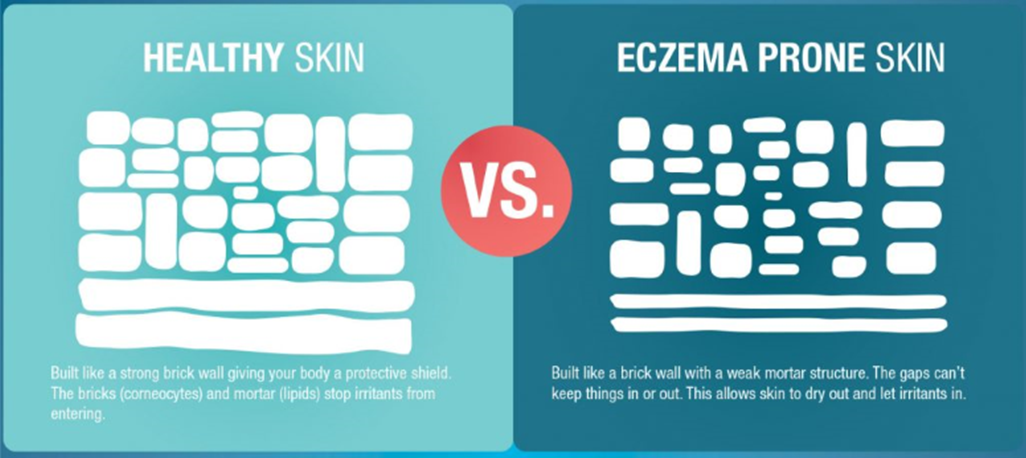
Creams and ointments may contain paraffin which is flammable. They can transfer from your skin on to clothing, bedding and bandages.
Do not smoke, use naked flames (for example: candles, BBQs, lighters, cigarettes) near your child or their bed.
What are emollients (moisturisers) and how do they work?
Emollients provide a coating on the skin which help protect the skin and improve the level of moisture. A variety of different types can be used at different times of the day depending on the condition of your skin. A cream may be preferred during the day and an ointment at night.
The vast majority of emollients can be used as a soap substitute. Regular soaps can cause irritation.
Types of emollients (moisturisers)
- Gels: which melt on the skin. Often contain preservatives which can sting if your child has very dry skin. Need to be applied frequently.
- Lotions: contain oil and water, very light to apply. Can contain preservatives which can sting if your child has very dry skin. Need to be applied frequently.
- Creams: water based. Can contain preservatives which can sting if your child has very dry skin. Need to be applied frequently.
- Ointments: provide the best skin barrier. Preservative free but thick and greasy. Not to be used if there is an infection on the skin.
The best emollient is the one your child is happy using regularly. Ointments have less preservatives and are excellent for overnight.
How much needed?
A thin shiny layer to the skin should be sufficient to all the affected areas. If treating the whole body approximately:
- 600g per week for an adult.
- 250g to 500g per week for a child.
Top tips
- As a moisturiser: smooth onto clean skin and apply as often as needed to prevent the skin becoming dry. Ideally it should be applied 2 to 4 times per day.
- As a cleanser: apply liberally to the skin and wipe off. Take care not to damage fragile skin.
- As a soap substitute: mix emollient with water in your palm. Apply to the skin in a downwards direction. Gently rinse off the skin, pat dry, and re apply.
- In the bath: ointments can be dissolved in water. Add a spoon full of ointment to a small amount of hot water in a jug. Then add to the bath water. Take care of the temperature of the water and when getting out of the bath, as it will be slippy.
How should emollients be applied?
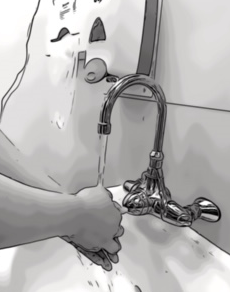
Step 1
Always wash your hands for 20 seconds before applying.
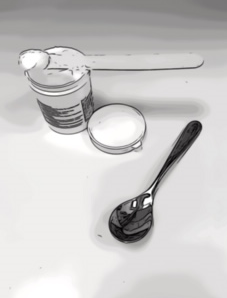
Step 2
Do not put your fingers into the tub as this can introduce bacteria and cause infection. Use a clean spoon or a spatula to take your emollient out of the tub.
If your emollient is in a pump this can be done straight on to your clean hands.
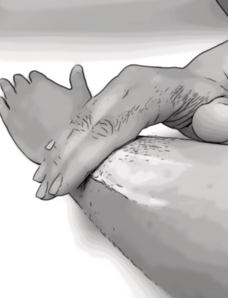
Step 3
Apply to the affected area in a downwards motion following the hair growth.
Do not rub in as this can block the follicles and cause infection.
Visit Eczema.org for more information
What are topical corticosteroids?
Topical corticosteroids are a form of medicine applied directly to the skin which helps reduce inflammation, redness and irritation. The type of steroid is similar to those produced naturally in the body.
Apply your emollient at least 30 minutes before or after applying a topical steroid.
What are the different strengths?
Your doctor or specialist nurse will identify the correct strength of steroid for different parts of the body and discuss how to increase or decrease treatment appropriately using the steroid ladder.
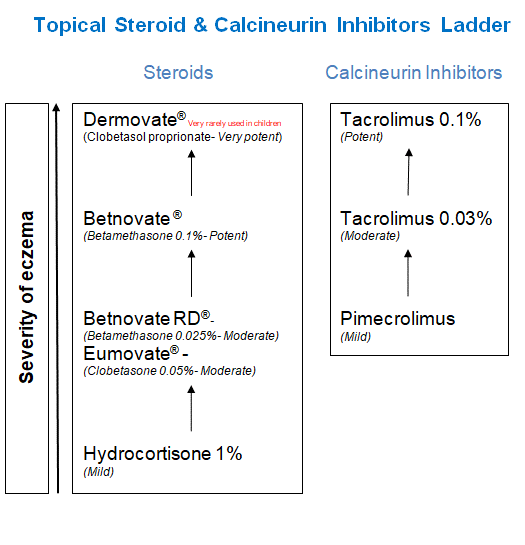
Children and young people will be guided by their doctor or specialist nurse about which steroid cream your child needs.
It is important that you follow the treatment plan given by your doctor or specialist nurse in order for your skin to avoid a flare of your skin condition. If used correctly topical corticosteroids should not cause side effects. Thinning of the skin and stretch marks will occur only if a strong steroid is used incorrectly or over a long time.
How to apply topical corticosteroids?

Step 1
Always wash your hands for 20 seconds before applying.
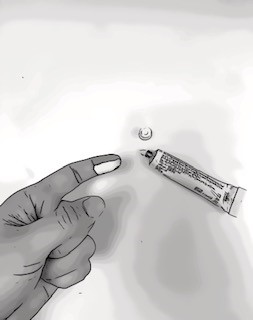
Step 2
Squeeze the topical steroid in a line from the last finger crease to the fingertip. This is a fingertip unit (FTU).
One FTU will be enough to treat an area the size of two adult handprints.

Step 3
Apply to the affected area in a downwards motion following the hair growth.
Do not rub in as this can block the follicles and cause infection.
How much topical corticosteroid should be applied?
One (FTU) fingertip unit would be enough to treat an area the size of two adult handprints. A thin shiny layer should cover the affected area.
The tables below can be used as a guide.
Children

Young people
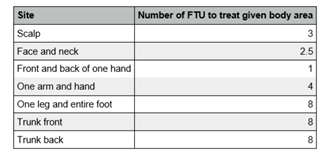
- If a topical corticosteroid causes irritation, please seek advice from your doctor or specialist nurse.
- If you are having ultraviolet light treatment or radiotherapy, check with your medical and nursing team if there is any specific guidance on your emollient use prior to starting treatment.
- Topical corticosteroids and emollients do not contain SPF and should not be used as sun protection. Sun creams should be used when skin is exposed to direct sunlight.
Wet wraps
Wet wrap bandages are two layers of medical grade viscose clothing or bandage. The first layer is applied wet and the second dry. Wet wraps help to moisten the skin and reduce irritation. Wet wraps can help intensify topical corticosteroid treatment. As the garment slowly dries out, the skin feels cooler which can help to reduce the itch sensation. They help break the itch, scratch cycle.
Common brands include Clinifast®, Comfifast®, Skinnies® and Tubifast®. They come in different sizes to suit different aged children.
Paste bandages
Paste bandages are soaked in zinc oxide or zinc oxide plus ichthammol. These ingredients make the bandage soothing and cooling which helps to relieve itching and soreness. Paste bandages have anti-inflammatory and antibacterial properties.
How do you apply paste bandages?
There is a special way to apply paste bandages because as they dry they can become tighter. Extra room is needed to make sure they remain comfortable. This technique should be demonstrated to you by a healthcare professional.
Do not apply around the neck, face or chest to avoid suffocation.
Wet dressings A3.6.indd (rch.org.au)
Arm Application (National Eczema Society, 2018)
- Wash your hands.
- Open the pack and remove bandage.
- Start at the hand and work up the arm. Wrap the paste bandage around the wrist, smoothing it into place. After each turn, reverse the direction of the winding to form a pleat.
- Continue up the arm and over the elbow, smoothing the paste bandage into place and reversing the direction of the winding (clockwise, anticlockwise) with each turn to make a pleat.
- Secure the paste bandage in place with a dry bandage.
- If the fingers are affected, small strips of paste bandage can be wrapped around individual digits and moulded for comfort.
Patch Application
- Wash your hands.
- Open the pack and remove bandage.
- Cut an appropriate size patch and apply directed to the skin.
- Secure in place with dry bandage. Alternatively secure in place with Cotton Garments.
Leg Application (National Eczema Society, 2018)
- Wash your hands.
- Open the pack and remove bandage.
- Start at the base of the toes and wrap paste bandage around the ball of the foot or heel, smoothing it into place. After each turn, reverse the direction of the winding to form a pleat.
- Continue up the lower leg and over the knee to the top of the leg. Smooth the paste bandage into place and reverse the direction of the winding (clockwise, anticlockwise) with each turn to make a pleat.
- Secure the paste bandage in place with a dry bandage.
- If the toes are affected, small strips of paste bandage can be wrapped around individual digits and moulded for comfort.
What are the possible side effects of paste bandages?
Commonly paste bandages are used with topical corticosteroids underneath which increases the strength of them. A healthcare professional should always discuss your treatment plan with you before using paste bandages and topical corticosteroids together.
Environmental Triggers
Skin conditions can be triggered by many environmental irritants which include house dust mite, pets, pollen, moulds, central heating, laundry and cleaning products. It is impossible to avoid all triggers but you can reduce these with some simple measures.
How to reduce house dust mites?
House dust mites are one of the biggest triggers in eczema and other skin conditions. They are tiny insects that feed on the skin we shed and are found in soft furnishings. You can reduce the amount of dust mites in your home by:
- Vacuum carpets regularly.
- Vacuum mattresses, pillows and covers at least twice a week.
- Damp dust surfaces and floors on a regular basis. Avoid dry dusting, as this can spread dust into the air.
- Wash bed linen weekly on a high temperature and wash curtains every 2 to 3 months.
- Limit soft toys. Have one special soft toy in the bed and wash this regularly on a high temperature, or put in a plastic bag in the freezer overnight to kill off the dust mites.
How to reduce irritation by pets?
It is not pet fur that causes an allergic reaction but its flakes of their skin, saliva and dried urine. It may not be possible to remove a pet permanently but you could:
- Keep pets outside the house as much as possible.
- Don't allow pets into bedrooms.
- Wash pets regularly.
- Open windows to increase ventilation.
How to reduce the impact of pollen?
Hay fever is triggered when trees and grasses release pollen into the air. Typically, people are affected during spring (trees) and summer (grasses).
To help keep this under control you could:
- Avoid drying clothes outside when pollen count is high.
- Keep doors and windows shut where possible.
- Shower and change clothes after being outside.
- Avoid grassy areas, such as parks and fields, particularly in the early morning, evening or night, when the pollen count is highest.
How to reduce mould?
Tiny particles released by moulds can also cause an allergic reaction in some people.
- Deal with any damp and condensation in your home.
- Keep your home dry and well ventilated.
- Don't store clothes in damp cupboards.
- Remove any indoor pot plants from your home.
How to reduce the impact of central heating?
Central heating reduces humidity and dries the skin, making it itchy. You could control this by keeping your house at 18°c. Hydrate your skin by applying moisturisers or emollient often when in the house.
How to reduce the impact of laundry and cleaning products?
People with eczema should take special care with the items that come into direct contact with their skin. Fragrances (perfumes) and detergents can cause skin reactions. Air fresheners, candles, wax melts and diffusers are also irritants and should be avoided.
To help keep this under control use non bio washing powder. Use your washing machine’s second or “extra rinse” setting if it has one. Do not use fabric conditioner.



